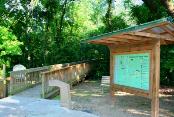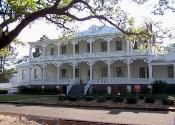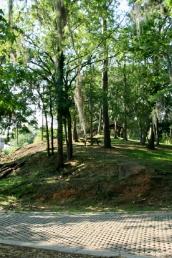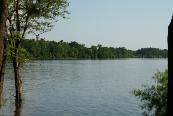Chattahoochee, Florida - Historic Sites & Points of Interest
Chattahoochee, Florida - Historic Sties & Points of Interest


| Chattahoochee from the Air The charming city of Chattahoochee is one of Florida's most historic and picturesque communities. It is located 44 miles west of Tallahassee. |
Chattahoochee, Florida
The historic Officers' Quarters
of the U.S. Arsenal was built
in 1834-1839 and is now part
of Florida State Hospital.
The historic Officers' Quarters
of the U.S. Arsenal was built
in 1834-1839 and is now part
of Florida State Hospital.


Jim Woodruff Dam
The dam was completed in
1958 to form Lake Seminole,
a beautiful reservoir that is
popular for a wide variety of
outdoor activities.
The dam was completed in
1958 to form Lake Seminole,
a beautiful reservoir that is
popular for a wide variety of
outdoor activities.
Chattahoochee, Florida - Historic Sites & Points of Interest
Florida's City on the Hill
| Copyright 2013 by Dale Cox All rights reserved. Last Updated: June 8, 2013 |


Custom Search
Historic Sites on the Apalachicola

Chattahoochee Landing
This prehistoric Indian mound
at Chattahoochee Landing
was part of a ceremonial
complex 1,000 years ago.
This prehistoric Indian mound
at Chattahoochee Landing
was part of a ceremonial
complex 1,000 years ago.

Apalachicola River
The Scott Massacre of 1817,
a battle of the First Seminole
War, took place at what is
now Chattahoochee.
The Scott Massacre of 1817,
a battle of the First Seminole
War, took place at what is
now Chattahoochee.
One of the most charming small cities in
Florida, Chattahoochee is nestled atop the
high bluffs that overlook the Apalachicola
River.
While the modern city was established as
Mount Vernon during the 1820s, its colorful
history dates back thousands of years. Over
the centuries, Chattahoochee has been the
location of Indian mound complexes, forts,
battles, the home port of a Confederate
warship, a Reconstruction era prison and the
Florida State Hospital.
The city's location near the confluence of the
Flint and Chattahoochee Rivers gives it
historical importance out of all proportion to
its size. The rivers served as early trade
routes by which prehistoric American Indians
moved goods and raw materials from points
as far flung as the North Georgia mountains
at Gulf of Mexico.
By the time of the Mississippian era (A.D. 900
- A.D. 1500), the strategic and commercial
importance of the high bluffs near the
confluence had become obvious. A powerful
chiefdom settled on the banks of the
Apalachicola at Chattahoochee and built one
of the most important ceremonial Indian
mound complexes in Florida.
The Chattahoochee Landing Mounds were
built roughly 1,000 years ago. Parts of three
of them can still be seen at Chattahoochee
Landing Park, but archaeologists believe the
complex once included at least seven
earthen mounds.
While archaeological investigations at the
site have been limited, the mounds are listed
on the National Register of Historic Places.
They are associated with Florida's Fort
Walton culture and recent study suggests
they were aligned to serve as something of a
giant astronomical observatory.
The mounds were abandoned by the time
Spanish explorers arrived in Florida, but
soldiers, priests and Christian Indians often
crossed the Apalachicola River at the site
during Florida's Spanish Mission era. River
Landing Road, which leads down to the river
from the top of the bluffs, was part of the real
Old Spanish Trail.
In 1799, Chattahoochee became the site of
the second known observatory and weather
station established in Florida. Andrew
Ellicott, the U.S. Commissioner of Limits,
was working with his Spanish counterpart,
Stephen Minor, to mark the border between
the United States and Spanish Florida. The
observatory was established to determine
the latitude and longitude at which the border
intersected the river.
Ellicott, Minor and their associates occupied
the observatory briefly until angry Creek and
Seminole warriors forced them to evacuate it
in great haste. The Indians were upset to see
white men dividing their lands. A marker
commemorating the observatory can be
seen at the intersection of Pearl and High
Streets.
The strategic importance of the land at the
confluence of the Chattahoochee and Flint
Rivers again became apparent during the
War of 1812. British forces landed at
Apalachicola Bay in May 1814 and soon
established a large fort and supply depot at
Prospect Bluff, 30 miles upstream from the
mouth of the Apalachicola.
To better secure this position, the British in
the fall of 1814 built a second fort atop the
largest of the prehistoric Indian mounds at
Chattahoochee Landing.
Called "Fort Apalachicola" by the American
military but more commonly known as
Nicolls' Outpost, this fort was a rectangular
earthwork and stockade that was armed with
two small cannon.
The outpost was the scene of an important
council in March 1815 in which a large group
of Creek and Seminole leaders appealed to
the King of England for help. The Creek
prophet, Josiah Francis, was delegated at
this conference to travel to Great Britain to
present this appeal in person.
Nicolls' Outpost was evacuated in April or
May 1815, but two years later Creek, African
and Seminole warriors hiding in the vicinity
ambushed a U.S. Army boat making its way
up the Apalachicola River. It was under the
command of Lieutenant Richard W. Scott of
the 7th U.S. Infantry and carried 40 soldiers,
7 women and 4 children.
The Scott Massacre of 1817 was the first U.S.
defeat of the four-decade long Seminole
Wars. Forty-four people on Scott's boat were
killed in a bloody disaster that led President
James Monroe to order Andrew Jackson's
1818 invasion of Florida. The battle led to
Florida becoming part of the United States.
Florida, Chattahoochee is nestled atop the
high bluffs that overlook the Apalachicola
River.
While the modern city was established as
Mount Vernon during the 1820s, its colorful
history dates back thousands of years. Over
the centuries, Chattahoochee has been the
location of Indian mound complexes, forts,
battles, the home port of a Confederate
warship, a Reconstruction era prison and the
Florida State Hospital.
The city's location near the confluence of the
Flint and Chattahoochee Rivers gives it
historical importance out of all proportion to
its size. The rivers served as early trade
routes by which prehistoric American Indians
moved goods and raw materials from points
as far flung as the North Georgia mountains
at Gulf of Mexico.
By the time of the Mississippian era (A.D. 900
- A.D. 1500), the strategic and commercial
importance of the high bluffs near the
confluence had become obvious. A powerful
chiefdom settled on the banks of the
Apalachicola at Chattahoochee and built one
of the most important ceremonial Indian
mound complexes in Florida.
The Chattahoochee Landing Mounds were
built roughly 1,000 years ago. Parts of three
of them can still be seen at Chattahoochee
Landing Park, but archaeologists believe the
complex once included at least seven
earthen mounds.
While archaeological investigations at the
site have been limited, the mounds are listed
on the National Register of Historic Places.
They are associated with Florida's Fort
Walton culture and recent study suggests
they were aligned to serve as something of a
giant astronomical observatory.
The mounds were abandoned by the time
Spanish explorers arrived in Florida, but
soldiers, priests and Christian Indians often
crossed the Apalachicola River at the site
during Florida's Spanish Mission era. River
Landing Road, which leads down to the river
from the top of the bluffs, was part of the real
Old Spanish Trail.
In 1799, Chattahoochee became the site of
the second known observatory and weather
station established in Florida. Andrew
Ellicott, the U.S. Commissioner of Limits,
was working with his Spanish counterpart,
Stephen Minor, to mark the border between
the United States and Spanish Florida. The
observatory was established to determine
the latitude and longitude at which the border
intersected the river.
Ellicott, Minor and their associates occupied
the observatory briefly until angry Creek and
Seminole warriors forced them to evacuate it
in great haste. The Indians were upset to see
white men dividing their lands. A marker
commemorating the observatory can be
seen at the intersection of Pearl and High
Streets.
The strategic importance of the land at the
confluence of the Chattahoochee and Flint
Rivers again became apparent during the
War of 1812. British forces landed at
Apalachicola Bay in May 1814 and soon
established a large fort and supply depot at
Prospect Bluff, 30 miles upstream from the
mouth of the Apalachicola.
To better secure this position, the British in
the fall of 1814 built a second fort atop the
largest of the prehistoric Indian mounds at
Chattahoochee Landing.
Called "Fort Apalachicola" by the American
military but more commonly known as
Nicolls' Outpost, this fort was a rectangular
earthwork and stockade that was armed with
two small cannon.
The outpost was the scene of an important
council in March 1815 in which a large group
of Creek and Seminole leaders appealed to
the King of England for help. The Creek
prophet, Josiah Francis, was delegated at
this conference to travel to Great Britain to
present this appeal in person.
Nicolls' Outpost was evacuated in April or
May 1815, but two years later Creek, African
and Seminole warriors hiding in the vicinity
ambushed a U.S. Army boat making its way
up the Apalachicola River. It was under the
command of Lieutenant Richard W. Scott of
the 7th U.S. Infantry and carried 40 soldiers,
7 women and 4 children.
The Scott Massacre of 1817 was the first U.S.
defeat of the four-decade long Seminole
Wars. Forty-four people on Scott's boat were
killed in a bloody disaster that led President
James Monroe to order Andrew Jackson's
1818 invasion of Florida. The battle led to
Florida becoming part of the United States.
Apalachicola, Florida
Historic Sites & Points of Interest
John Gorrie Museum Historic State Park
Chapman Botanical Gardens
Fort Gadsden Historic Site
Apalachicola Bluffs & Ravines Preserve
Torreya State Park
Battle of Ocheesee
Scott Massacre of 1817
Chattahoochee Landing Mounds
Nicolls' Outpost
Historic Sites & Points of Interest
John Gorrie Museum Historic State Park
Chapman Botanical Gardens
Fort Gadsden Historic Site
Apalachicola Bluffs & Ravines Preserve
Torreya State Park
Battle of Ocheesee
Scott Massacre of 1817
Chattahoochee Landing Mounds
Nicolls' Outpost
By the early 1820s, settlers were living at
present-day Chattahoochee and a ferry was
established on the Apalachicola River at
Chattahoochee Landing. The settlement was
first known as Mount Vernon and grew to
become a river port for the planters of
Gadsden County.
Its strategic location at the head of the river
led the U.S. Army to select the village to
become the site of Florida's only arsenal.
Construction on this four-acre complex
began in 1834 and it was completed in 1839.
Surrounded by a strong brick wall and
named the Apalachicola Arsenal after the
river itself, the fortification stood on the
grounds of today's Florida State Hospital.
Confusion in the mails caused by the fact
that there were arsenals in towns named
Mount Vernon in both Florida and Alabama
led to the renaming of the community to
Chattahoochee.
The U.S. Arsenal at Chattahoochee was
seized by the state militia of Florida on
January 6, 1861, and became the first military
installation in Florida to fall to what would
become the Confederate States of America.
The Confederate army used it as a camp of
instruction and barracks for the duration of
the war. It was reoccupied by the U.S. Army
after the fall of the Confederacy.
In 1869 the arsenal was turned over to the
state for use as a prison, a function that it
served through the Reconstruction era.
Among those held there were political
prisoners who opposed Florida's occupation
government after the Civil War.
In 1876 the complex was converted for use
as a hospital for the mentally ill. The original
Officers' Quarters, listed on the National
Register of Historic Places, now serves as
the Administration Building of the Florida
State Hospital. The medical facility is
Chattahoochee's largest employer.
Chattahoochee's status as a river port was a
major part of its history from the 1820s until
the 20th century. A tavern was built atop one
of the Indian mounds at the landing and
paddlewheel steamboats once docked at a
wharf there. The CSS Chattahoochee used
the landing as its homeport during the Civil
War and the ferry continued to operate until
the river was bridged during the 20th Century.
The completion of the Jim Woodruff Dam in
1958 created Lake Seminole on the Florida -
Georgia border. Covering tens of thousands
of acres, it is popular for outdoor recreation
and Chattahoochee is a major gateway.
Chattahoochee today is a peaceful and
charming community that is known for its
scenery, nature trails, historic sites, quaint
business district , oak-lined streets and
beautiful Angus Gholson Nature Park.. It is a
gateway to both Lake Seminole and the
Apalachicola River, a major eco and heritage
tourism destination.
Chattahoochee is located 44 miles west of
Tallahassee and can be reached via either
US 90 or from Exit #166 on Interstate 10. The
city offers cabins and RV hookups at its
Chattahoochee RV Park.
To learn more, please visit the city's website
at www.cityofchattahoochee.com.
present-day Chattahoochee and a ferry was
established on the Apalachicola River at
Chattahoochee Landing. The settlement was
first known as Mount Vernon and grew to
become a river port for the planters of
Gadsden County.
Its strategic location at the head of the river
led the U.S. Army to select the village to
become the site of Florida's only arsenal.
Construction on this four-acre complex
began in 1834 and it was completed in 1839.
Surrounded by a strong brick wall and
named the Apalachicola Arsenal after the
river itself, the fortification stood on the
grounds of today's Florida State Hospital.
Confusion in the mails caused by the fact
that there were arsenals in towns named
Mount Vernon in both Florida and Alabama
led to the renaming of the community to
Chattahoochee.
The U.S. Arsenal at Chattahoochee was
seized by the state militia of Florida on
January 6, 1861, and became the first military
installation in Florida to fall to what would
become the Confederate States of America.
The Confederate army used it as a camp of
instruction and barracks for the duration of
the war. It was reoccupied by the U.S. Army
after the fall of the Confederacy.
In 1869 the arsenal was turned over to the
state for use as a prison, a function that it
served through the Reconstruction era.
Among those held there were political
prisoners who opposed Florida's occupation
government after the Civil War.
In 1876 the complex was converted for use
as a hospital for the mentally ill. The original
Officers' Quarters, listed on the National
Register of Historic Places, now serves as
the Administration Building of the Florida
State Hospital. The medical facility is
Chattahoochee's largest employer.
Chattahoochee's status as a river port was a
major part of its history from the 1820s until
the 20th century. A tavern was built atop one
of the Indian mounds at the landing and
paddlewheel steamboats once docked at a
wharf there. The CSS Chattahoochee used
the landing as its homeport during the Civil
War and the ferry continued to operate until
the river was bridged during the 20th Century.
The completion of the Jim Woodruff Dam in
1958 created Lake Seminole on the Florida -
Georgia border. Covering tens of thousands
of acres, it is popular for outdoor recreation
and Chattahoochee is a major gateway.
Chattahoochee today is a peaceful and
charming community that is known for its
scenery, nature trails, historic sites, quaint
business district , oak-lined streets and
beautiful Angus Gholson Nature Park.. It is a
gateway to both Lake Seminole and the
Apalachicola River, a major eco and heritage
tourism destination.
Chattahoochee is located 44 miles west of
Tallahassee and can be reached via either
US 90 or from Exit #166 on Interstate 10. The
city offers cabins and RV hookups at its
Chattahoochee RV Park.
To learn more, please visit the city's website
at www.cityofchattahoochee.com.
Apalachicola River
Chattahoochee Landing Mounds
CSS Chattahoochee Memorial
Nicolls' Outpost (War of 1812)
Scott Massacre of 1817
U.S. Arsenal at Chattahoochee
Historic Sites in Florida
Forts & Battlefields of the South
Explore other Southern Historic Sites
Chattahoochee Landing Mounds
CSS Chattahoochee Memorial
Nicolls' Outpost (War of 1812)
Scott Massacre of 1817
U.S. Arsenal at Chattahoochee
Historic Sites in Florida
Forts & Battlefields of the South
Explore other Southern Historic Sites
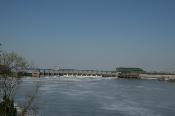
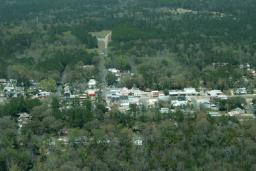

Civil War Dead
This monument on South
Main Street in Chattahoochee
honors the men who died in
an explosion aboard the CSS
Chattahoochee.
This monument on South
Main Street in Chattahoochee
honors the men who died in
an explosion aboard the CSS
Chattahoochee.

Award-Winning Trails
Chattahoochee is noted for its
system of award-winning
trails. Accessed from either
Chattahoochee Landing or
the Angus Gholson Nature
Park, they provide a great way
to explore the beauty and
unique plants of the area.
Chattahoochee is noted for its
system of award-winning
trails. Accessed from either
Chattahoochee Landing or
the Angus Gholson Nature
Park, they provide a great way
to explore the beauty and
unique plants of the area.
